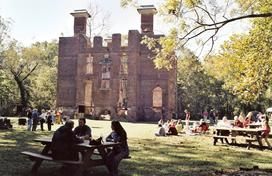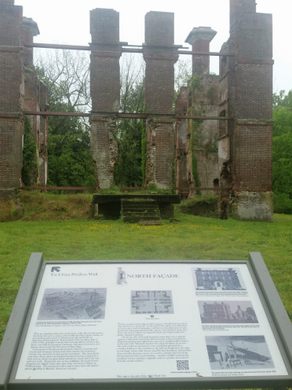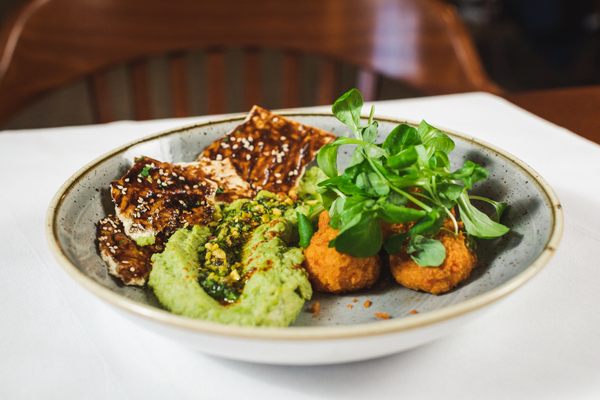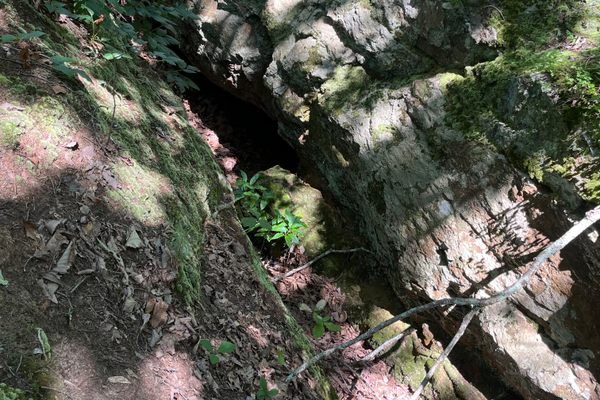The Rosewell Plantation Ruins
This once-palatial plantation may have been the site where a draft of the Declaration of Independence was written.
An exposed brick frame and stacked fireplaces are all that remain of a once-grand plantation called Rosewell. Built by the powerful Page family, the estate dates back to colonial Virginia, long before the Revolutionary War.
Rosewell Plantation was built by a descendent of one of the “First Families” of the Virginia Colony, who settled in Gloucester County in 1627. Almost a century later, in 1725, Mann Page I embarked on creating a grand estate in the style of London’s “townhouses” of the time. His dream was to outshine the Governor’s Palace in nearby Williamsburg. Rosewell’s brickwork (known as “Flemish bond”) was extraordinary, the three-story height was striking, and its setting at the York River was sublime — but Mann Page wouldn’t live to see it completed. He died five years later, and the home — by far the most impressive and imposing one in Virginia at the time — was finished by his son, Mann Page II in 1737.
Rosewell’s connection to the American Revolution came through Mann Page’s grandson, John. He was a close friend and classmate of Thomas Jefferson at William & Mary, and Jefferson visited often. (There are rumors that the “original rough draft” of the Declaration of Independence was written here, but no historians support that story, since Jefferson was in Philadelphia for most of 1776.) Jefferson may have written “A Summary View of the Rights of British America” at Rosewell. This document was the precursor to the Declaration of Independence.
Chattel slavery is a significant part of Rosewell’s legacy. As an expansive tobacco plantation, the Page family enslaved many people, at least 111 documented in the 18th century alone. Much of the 18th century documentation, including property inventories and tax records were destroyed by a fire at the Gloucester Courthouse, however 19th century records maintained by owner Josiah Deans document at least 68 enslaved people and their occupations at the close of the Civil War in 1865.
The plantation stayed in the Page family for 100 years, when in 1837 it began a bumpy journey through four or five different families. Maintaining such an estate was expensive, and the new owners began selling off both acreage and features of the house. The lead roof was sold, and even the marble mantels and mahogany paneling were ripped out and disposed of for cash.
Rosewell stumbled through the 19th and early 20th centuries, and in 1916, after surviving through Revolutionary and Civil War, the home was destroyed by fire. Today the remaining grounds and ruins are run by a caretaker foundation, but at its height the plantation consisted of 3000 acres, several outbuildings, the largest icehouse in the region, elaborate stables, and a magnificent English Garden.
Know Before You Go
The plantation ruins are about 25 miles north of Newport News, Virginia, on the north side of the York River. The Exhibit Center and Ruins are open between April 1 and October 31. Rosewell is closed on Mondays, and between November 1 and March 31. Hours are Tuesday thru Saturday from 10:00am to 4:00pm, and Sunday from 1pm to 4pm. General admission is $6-ages 12 and up, groups of 10 or more - $5, children 6 to 11 - $4, under 6 and current Friends of Rosewell members are free.




























Follow us on Twitter to get the latest on the world's hidden wonders.
Like us on Facebook to get the latest on the world's hidden wonders.
Follow us on Twitter Like us on Facebook